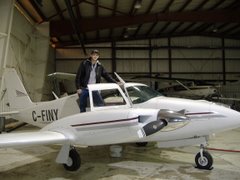Well here is my post on landing the twin as promised. Hopefully I haven't lost too many people to confusion or boredom from the last post. I promise the next one will be less technical.
So here we are, screaming along in our twin. We've been cleared to the downwind, so now we're flying parallel to the runway in the opposite direction, at circuit altitude, which is 1000 ft above the airport. If we haven't already we'll pull the power back to around 17 " of Manifold Pressure, which is about half power, so we can slow down. We'll let our speed bleed off a little. Now we need to get our pre-landing check done. Mixtures go to full rich, fuel selectors should be on main tanks, electric fuel pumps on, and once our airspeed has dropped below 150 mph, we can drop the landing gear, and we'll watch for our green light, indicating the gear is down and locked. The gear will be slowing us down even more, so now once we're below 125 mph, we can lower the flaps.
At this point, we'll be ready to turn onto our base leg, which is 90 degrees to the runway. We slow down to our initial approach speed which will usually be 120 mph, unless we're following in a slower plane and we need to go slower to give them more spacing. Soon enough we'll be ready to turn onto our final leg, lining us up with the runway. I have to remember to not wait too long to turn, otherwise I'm going to turn too late, and have to do an S turn to get ourselves lined up again with the centreline. This isn't a Cessna 150 and it won't turn on a dime as I'm used to. Final approach speed will be 110 mph. Once we're established on final we do our G.U.M.P. check. G.U.M.P. is an acronym for Gas, Undercarriage (landing gear), Mixtures, and Propellers. This means we want to double check that our fuel pumps are on, and fuel selectors on the main tanks, our undercarriage is down and locked (belly landings are quite exciting I hear but not very cost-effective), Mixtures are rich, and Propellers are full forward. All this, with the exception of the landing gear, doesn't really matter a whole lot for landing, but we want to be already set up to climb out if we have to overshoot for whatever reason. So as long as we've been cleared to land we're good to go. All we have to do is fly the airplane down over the threshold, slowly retard the throttle and flare (raise the nose to bleed off our airspeed and touch down on the main wheels).
The flare I find is a much smaller angle in comparison to a Cessna 150 or 172. The airplane is travelling faster and needs more time to slow down and settle onto the runway. I initially had problems flaring too much, and the airplane would zoom up, bleed off its airspeed, and then drop onto the runway - hard on the airplane and it does a number on your back too! All we need is just a very slight nose up attitude and hold it there until our airspeed decreases and the airplane settles onto the runway. Once we've got all three wheels onto the runway its just a matter of applying the brakes and stopping straight ahead. Onto the ground once more safely and uneventfully, just the way we like it!
Subscribe to:
Post Comments (Atom)




No comments:
Post a Comment